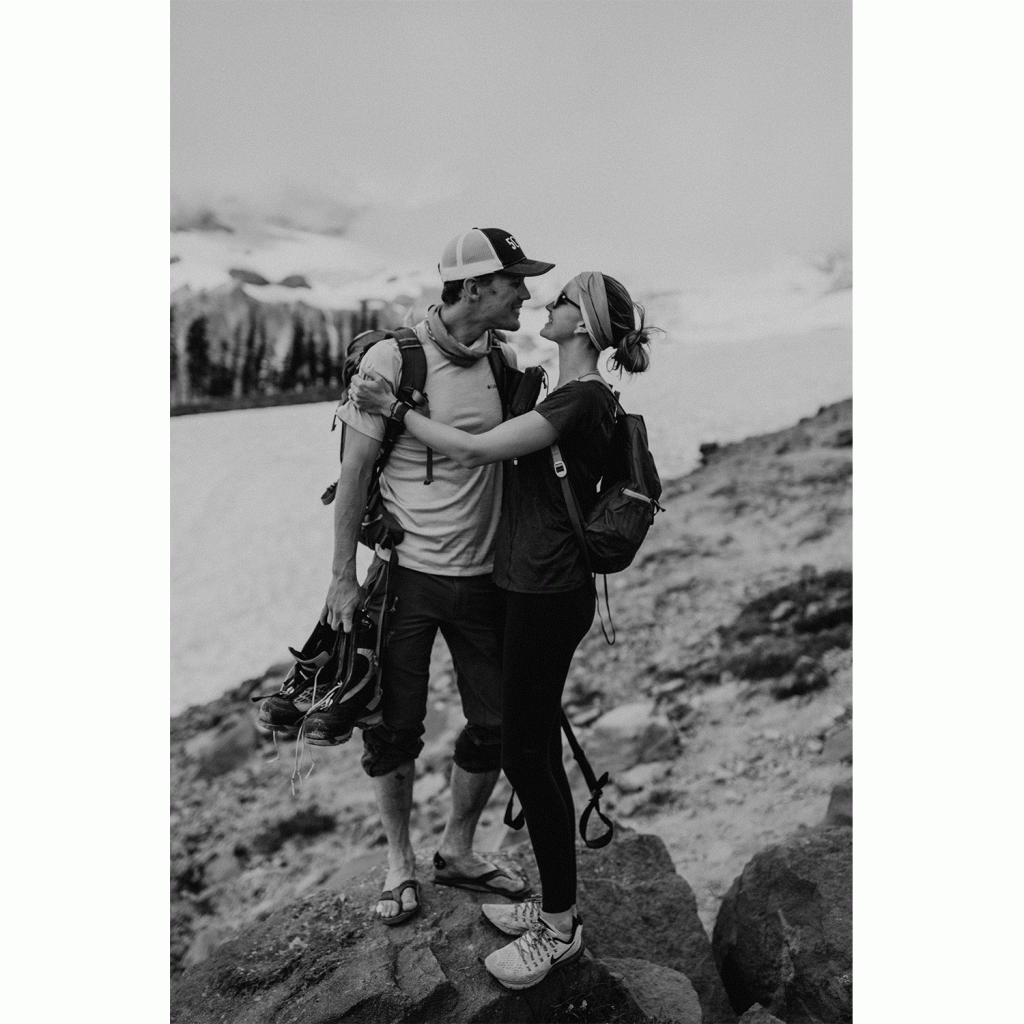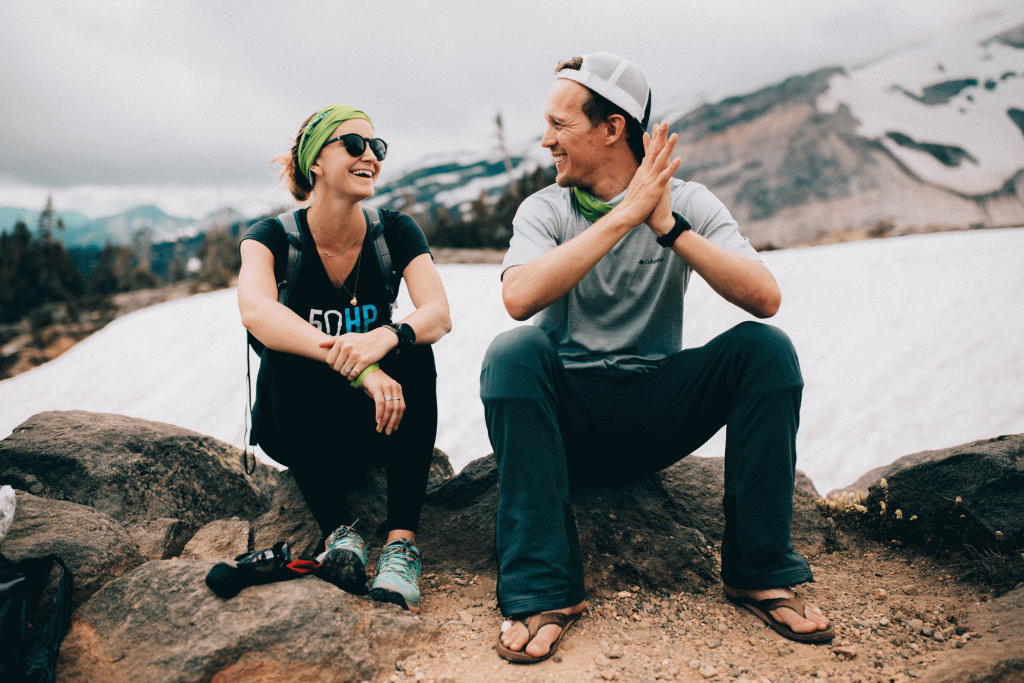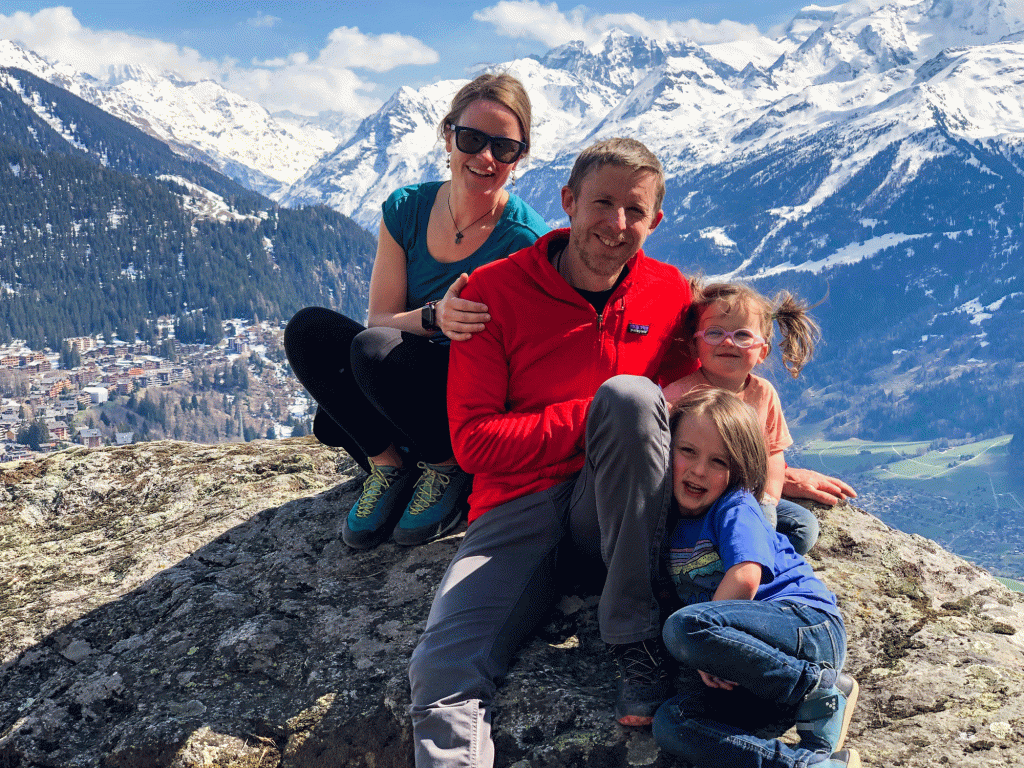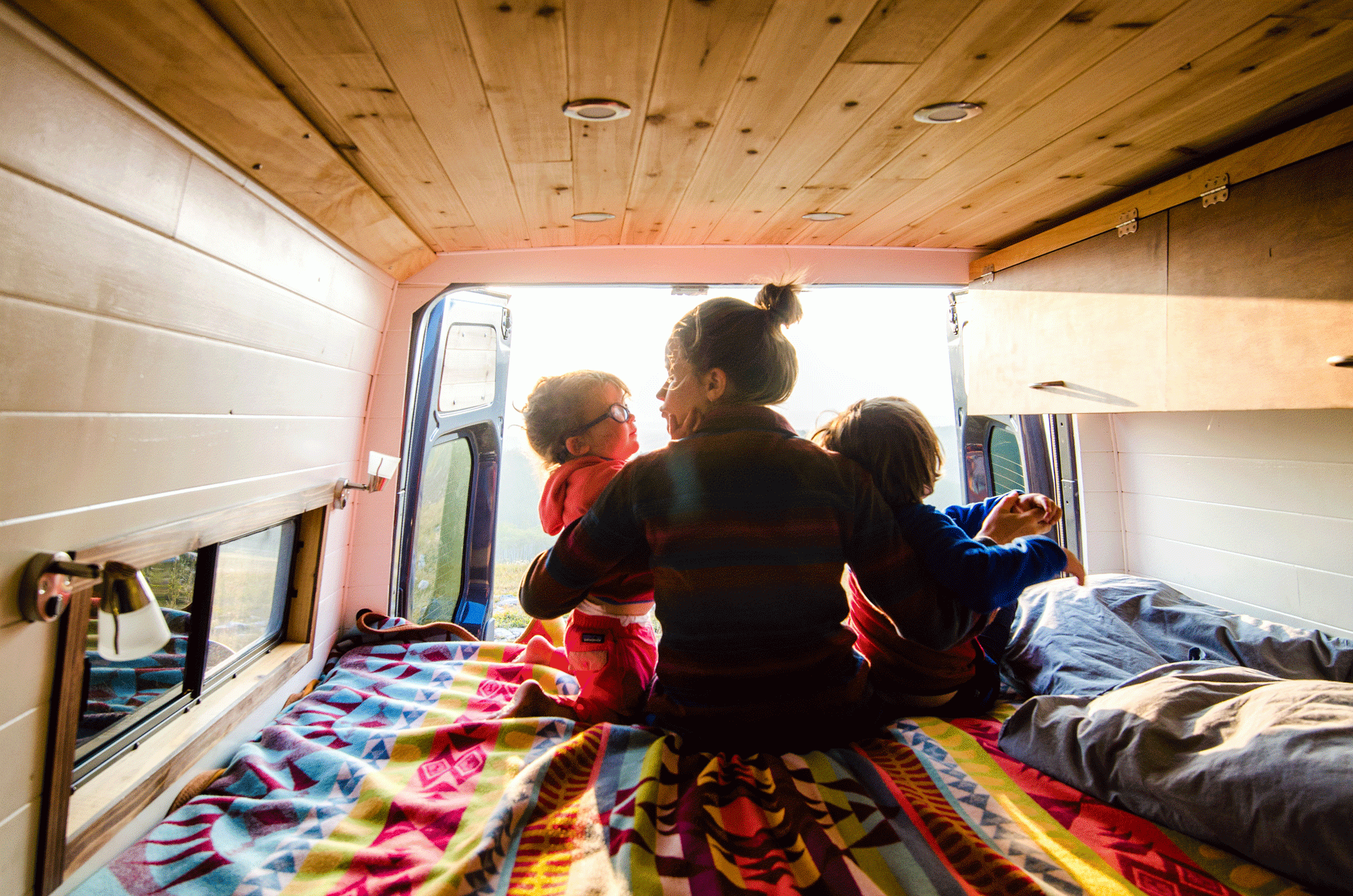Shadows chased the last light up the ramparts of Yosemite Valley as Becca Caldwell rocked her 18-month-old son Fitz to sleep in the van she called home when she was away from her house in Estes Park, Colorado, in 2015. Hanging in space from the sheer cliff above, Fitz’s father, Tommy Caldwell, was living a stint on El Capitan’s Dawn Wall, years deep into his mission to make first free ascent of the 3,000-foot face with Kevin Jorgeson.
Becca knew the ins and outs of the route; she’d spent the early days of the quest on the wall, belaying Tommy and photographing the project. And when Jorgeson injured his ankle in 2011 falling during one of the trickiest moves, Tommy nearly abandoned the effort until Becca stepped in.
“I said to him, ‘You can’t be done now, you’re feeling strong.’” she recalled. “I went up there to belay him and was on the wall for the first 11 days of that push.”
But The Dawn Wall, the acclaimed 2018 film on Caldwell and Jorgeson’s world-renowned feat, doesn’t show any of that.
“It was a gigantic part of my life and relationship,” she says. “When the film was finished, I was just the supportive wife. But I wasn’t standing back and watching it happen. I was very invested, and I’d spent so much time on the wall. I don’t expect to be celebrated. But I did have a moment where I thought, I got cut out of my own story.”
Becca is one of the “dream makers,” a term she coined to describe the partners who help catapult an adventurer to athletic glory, aiding them in accomplishing feats like freeing the Dawn Wall; completing the first solo, unsupported crossing of Antarctica; or becoming the first person to ski off all seven summits.
Outside of the spotlight, the dream makers keep daily life running—paying bills, caring for young children, managing the family business, and in some cases, putting their own ambitions on hold—for the duration of long expeditions. Some, like Becca, even put their own sweat and tears into the project, offering psychological and logistical support while acknowledging the adventurer may not return home from a dangerous goal.
These are the stories of three of the dream makers behind a few of the most celebrated adventurers of our time, and a look behind the curtain at what goes into achieving those heralded feats.
Becca Caldwell met Tommy Caldwell in 2010, when she was fresh out of nursing school and just getting into climbing. After six months of friendship, Tommy asked her to join him in Yosemite. It was a seminal trip. While shooting with filmmaker Josh Lowell, Tommy hatched his plan of becoming the first climber to free The Dawn Wall; he also told Becca he had feelings for her for the first time.
The following fall, in 2011, Becca landed a position at a clinic in Estes Park while Tommy traveled frequently for climbing. “It was a pretty low-paying nursing job and one I wasn’t feeling overly set on,” Becca says. “I thought, we could spend all this time apart, or we could just go on the road together and see what happens.” She quit her job and began traveling with Tommy. Life became a mix of pursuing her own climbing goals in between stints in Yosemite as Tommy started devoting himself to the Dawn Wall in earnest. She also started taking photos, a talent she was eager to develop.
Then Becca got pregnant with their first child, and everything changed.
***
On December 26, 2018, after 54 grueling days on the ice, Colin O’Brady completed the first solo unsupported crossing of Antarctica. He celebrated the moment victoriously on his Instagram account via satellite, tagging his wife, Jenna Besaw: “You walked every step of the way with me and guided me with your courage and strength … We turned our dream into reality.”
When asked whether it was her own dream that O’Brady undertake and complete this expedition, Besaw replies with a definitive absolutely. She sees his expeditions as a family business, a joint undertaking.
“We’ll dream up a goal and plan it together, and then I run the branding and PR. My full heart goes into it,” Besaw says. “It’s a level beyond what most people would characterize as my job; it’s a huge piece of my identity and what I love to do.”
The duo met on a tiny island in Fiji in 2007, eventually settling in Portland, Oregon, where Besaw put a newly acquired degree in international relations and politics to work on a mayoral campaign. O’Brady applied himself toward a growing career as a professional triathlete.

Jenna Besaw and Colin O’Brady embrace during O’Brady’s 2018 50HP project, during which O’Brady set the speed record for reaching all 50 high points in the U.S. (Photo Credit: Berty Mandagie)
“We lost that campaign, and the whole thing was an insight into that kind of life—and I wasn’t that interested,” Besaw recalls. “Colin had been traveling, and we realized it made for a lot of life apart.”
In the summer of 2012, she joined him on the road, zigzagging from race to race. The marketing side of professional athleticism quickly appealed to her: “That was the inception: this question of how do you market and brand someone as an athlete; create a story around their life and what they’ve been through, and make it beautiful.” She developed and managed the marketing for O’Brady’s triathlete career for six years before the two leveled up to multiday expeditions.
In 2016, O’Brady launched an attempt to set the speed record on reaching the highest peak on each of the seven continents as well as the North Pole and South Pole—a challenge known as the Explorers Grand Slam. Alongside the expeditions, Besaw and O’Brady founded Beyond 7/2, a nonprofit designed to help kids live healthy lives; the pair provides motivational speaking and curriculum to participating schools.
Though O’Brady shattered the existing Explorers Grand Slam record in 2016, it was his next mission that won him fame. Besaw and O’Brady dubbed it “The Impossible First,” a solo unsupported crossing of Antarctica. Besaw leaned into the challenge, helping to shoulder much of the mammoth logistical planning and implementation that goes into the front end of such a mission.
She led the support team, checking in with him every night on the ice via satellite phone to rule out signs of frostbite and other maladies that had doomed other expeditions. And she devised the branding and social media strategy, receiving O’Brady’s Instagram images via an excruciatingly slow satellite transmission to update his feed in real-time. She conceived of and ran the hugely successful PR campaign that landed O’Brady’s attempt in major media all over the world. All the while, she directed Beyond 7/2’s new Antarctica-based school curriculum on history, culture and science.

Jenna Besaw and Colin O’Brady rest together during O’Brady’s 2018 50HP project. (Photo Credit: Berty Mandagie)
But for all her contributions, Besaw is content to leave the attention to O’Brady. “I’m not a huge lover of being in the spotlight,” she says. “Colin does an incredible job of shining light on the work we both do. That’s all I need and that’s enough. It’s about our shared love and encouragement behind closed doors that’s most meaningful to me.”
***
When the Caldwells had their first child, Becca’s capacity morphed into a support role for the family. It’s the moment she can pinpoint putting her own ambitions on hold for the sake of the Dawn Wall. She took on the primary caregiver role while Tommy continued his pursuit of the route—something that Becca, in recognizing Tommy’s potential, gave him a green light to do.
It had become clear that seasonal pushes on the wall weren’t enough for Jorgeson and Tommy to make headway and something needed to change; more concentrated time on the route seemed the obvious answer. “We had this huge shift together. I said, ‘Okay: you have this free pass from family obligations, social gatherings, whatever, to put this at the forefront of everything,’” she says.
Becca adopted a decidedly adventurous parenting style. Beginning in 2013, she drove to Yosemite with newborn Fitz, living in the van and taking the baby for hikes, or bouldering while he napped by the crash pad, so they could spend time with Tommy when he wasn’t on the wall.
She stationed herself in Yosemite with Fitz when Tommy and Jorgeson sent their historic 19-day push on the Dawn Wall. And she dodged the press and spectators who accumulated in El Cap Meadow, ushering Fitz to the nearby Merced River so he could throw rocks in the water. When Tommy and Jorgeson sent the final pitch, she hiked to the top of El Cap to meet them while Tommy’s family looked after Fitz.
Becca spoke to Tommy daily from the valley, offering encouragement and psychological support. “Tommy was able to be vulnerable and let out his true concerns and questions with me,” Becca says. “He couldn’t do that with Kevin because it could change the whole atmosphere; you don’t want to take away from the moment or create cracks in the direction forward. Being able to be that person with Tommy was a good and healthy thing. For me, that gave us closeness throughout the process.”
***
It isn’t only women who fill these roles of dream makers. It might be more common, simply because adventure sports have historically been dominated by men, but it’s not a given.
Mountaineering hero Junko Taibei, who in 1975 became the first woman to summit Everest, left her three-year-old daughter at home with her husband Masononu Tabei on that expedition, and he continued to support her while she climbed all seven summits.
And it isn’t only straight, cisgender athletes who benefit from dream-making partnerships, either. Consider Matt Wilkas’ support of Gus Kenworthy’s freestyle skiing career; Zhen Heinemann’s backing of triathlete Chris Mosier, who is also the first transgender member on Team USA; and Nikki DiSanto, who helped Keala Kennelly rise to world-surfing champion fame.
Rob DesLauriers, who is married to ski mountaineer Kit DesLauriers, understands what it’s like better than most to support a partner in an expedition-based career. Now a realtor in Jackson, Wyoming, Rob was a professional skier and cinematographer for nearly 20 years before he met Kit on an expedition in Siberia while filming for The North Face. Early in their relationship, the pair completed a number of joint trips, including climbing and skiing Mount Aspiring in New Zealand in 2003 and Denali in Alaska in 2004.

Kit and Rob DesLauriers took their daughters to Everest Base Camp in 2017 to share their love of mountain expeditions. (Photo Courtesy: Rob DesLauriers)
Then Kit dreamed up the idea of climbing and skiing the seven summits.
“I knew that was her project,” he says. He accompanied her and documented the journey; Kit ticked off that goal in 2006.
Kit was signed to The North Face in 2007, the year after she skied off Everest as the seventh summit—the same year the pair had their first daughter. Rob had already transitioned to real estate work, providing a stable support system as Kit began to combine her love of mountaineering with advocacy for the preservation of the Arctic National Wildlife Refuge in Alaska’s Brooks Range.
“An expedition is a great metaphor for anything in life,” Rob says. “You start in the city and walk slowly into the mountains … By then you’re acclimatized to the overall aspects of the situation. By the time Kit started leaving on longer expeditions again, taking care of the kids and running the house was more natural. It’s not like you’re dropped on Camp 2 in Everest.”
Rob is well aware of the risks on the big mountain expeditions Kit favors. When she leaves to pursue technical peaks and first descents, Rob doesn’t let himself worry. “You can’t really go there. That’s living out of fear,” he says.
Becca, too, must confront risk when Tommy takes on daunting expeditions. In 2018, when Tommy and Alex Honnold set the speed record on the The Nose on El Capitan, she says: “My nervousness was directly related to the accidents that have happened with speed climbing and previous attempts. … I questioned pretty hard whether it was what he really wanted and worth the risk involved. We know that if something happens, I’ll be okay. I’ll be heartbroken, and it would be the hardest thing, but I went into my relationship with Tommy knowing that. But being a parent with two kids… your life isn’t your own anymore.”
Her support comes down to placing faith in Tommy’s judgment—a conviction echoed by Besaw and DesLauriers. “I trust Tommy. I have to. I choose to. Sometimes things are going to happen out of our control, but you can’t hold on to thinking you can prevent things.”

The entire Caldwell family in their preferred environment. The family travels together often for Tommy’s climbing goals. (Photo Credit: Becca Caldwell)
When she has the rare moment to take the time to reflect, Becca notices that overall, she’s content with the life she and Tommy have together. She’s always been happy to help Tommy’s dreams come to life and be part of them, and she cherishes this time with her children while they’re young.
She’s also resolved to focus more on her own ambitions and goals, though she’s not positive what those are yet, since she’s given so much of herself to her family. Right now it’s as simple as finding consistent solo time to go out on her own adventures. “At some point I’ll make space to think about it. Life has been so crazy, and I’ve just been reacting to everyone’s schedules. I’m trying to be intentional with my time and the things that I’m doing, to get out and feed myself,” she says. “I think everyone’s better when we’re all getting fed.”
